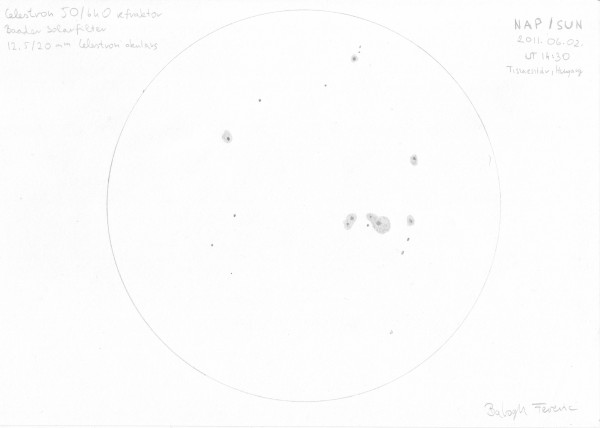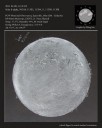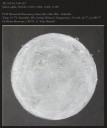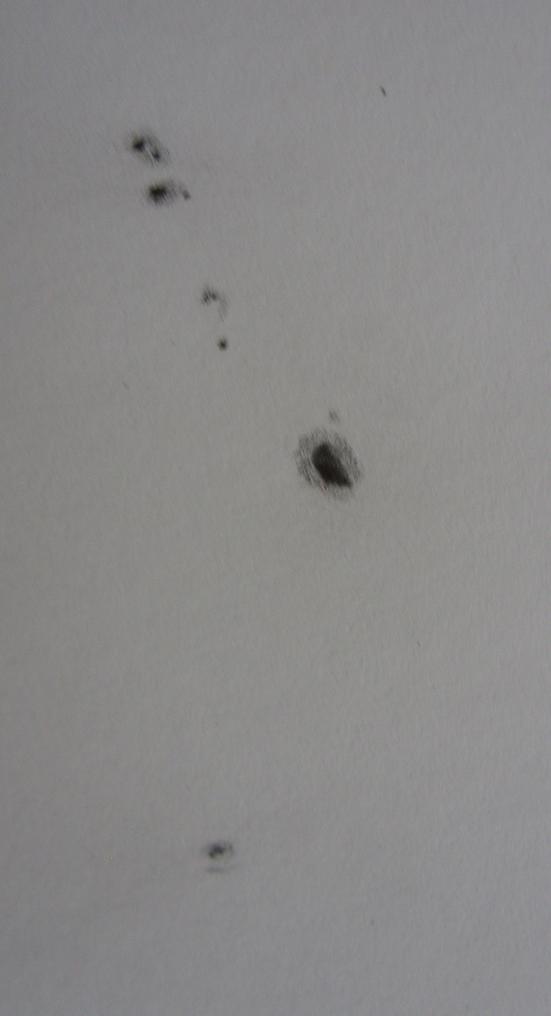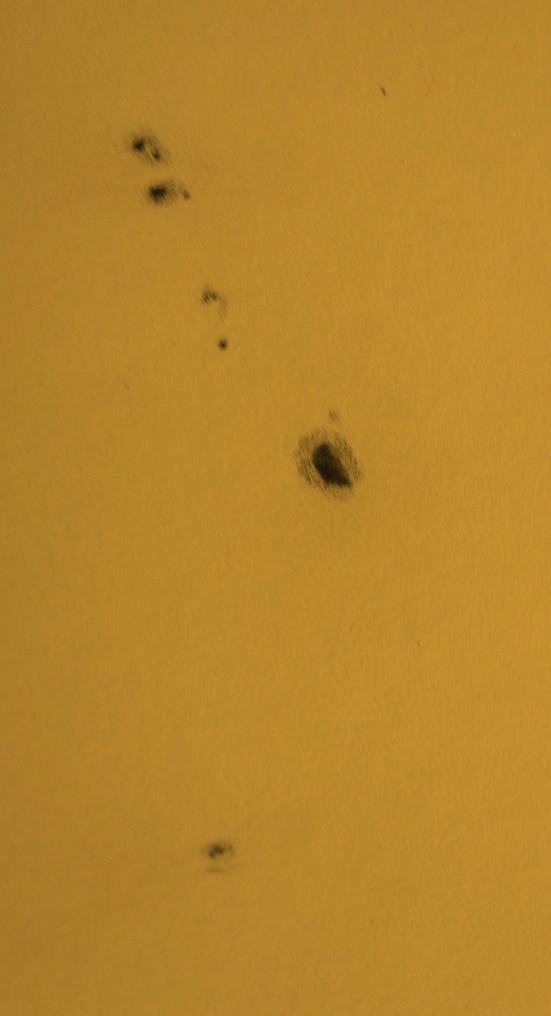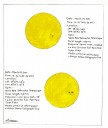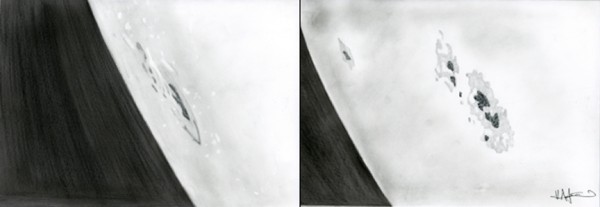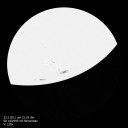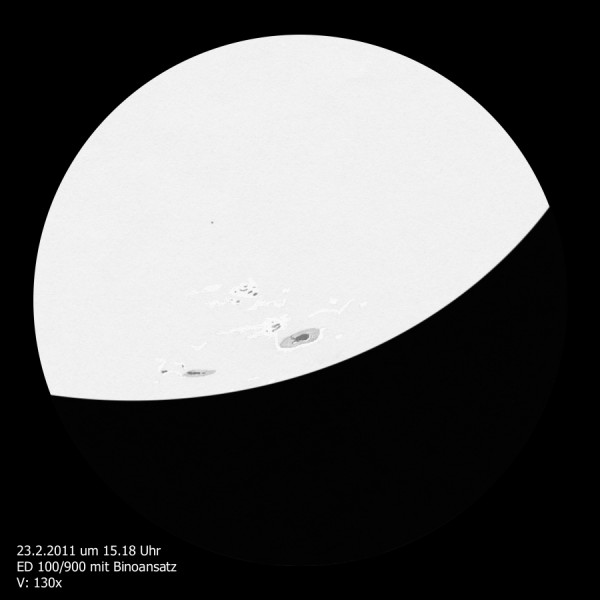Equipment: 50/640 Celestron refraktor, 20;12,5mm okular, Baader solar filter, graphite pencil, white paper
2011.06.02. UT 14:30
Tiszaeszlár, Hungary
Category: white light
New Active Region
2011 05 09, 1429UT-1550UT
Solar NOAA 11203, 11204, ??, 11209, 11208
www.pcwobservatory.com
PCW Memorial Observatory, Zanesville, Ohio USA – Erika Rix
DS 60mm Maxscope, LXD75, 21-7mm Zhumell, ETX70 AT w/tilt plate and white light glass filter.
All sketches done scopeside and flipped in Photoshop to match standard orientation. H-alpha sketch created with black Strathmore Artagain paper, white Conte’ crayon and pencil, Derwent charcoal pencil, black oil pencil. White light sketch created on photocopy paper with 0.5mm mechanical pencil and #2 pencil.
Transparency made it nearly impossible to view prominences at the start of the session with the thin layer of cirrus creating a milky white sky. There were small breaks that allowed me to sketch in some of the detail on a western prominence, that later as the transparency improved, showed an abundance of thin whispy structure that wasn’t captured on paper. By that time, I was already working on a full disk sketch in h-alpha. Seeing was terrific until I started on the white light observation, but had I set up the ETX at the beginning of the session to let the scope adjust to the warmth, it would have been much better by the time I observed with it. As it was, I observed in the observatory for protection of the wind as I view with a shade attached to the objective and wanted to avoid vibration.
There is a possible new active region between 1209 and 1208 that, while observing in white light, had several little spots forming an elliptical shape with pointed ends like a football. I noticed facula around 1208, but the seeing was so bad that I couldn’t make out a definite shape. The umbra of the preceding spot in that region was displaced, as was the preceding spot in 1203. I didn’t notice any sunspots in 1209 during my observation, but that may have been the result of the seeing.
The band of active regions is still putting on a nice show in h-alpha with more-defined plage around them.
Our Star Revealed
2011 05 05, 1230 UT – 1515 UT
Solar h-alpha, NOAAs 11203, 11204, 11205, 11207 and prominences
PCW Memorial Observatory, Zanesville, Ohio USA – Erika Rix, www.pcwobservatory.com
Temp: 22.5°C, Humidity 38%
Seeing: Wilson 4, Transparency: 3/6
DS 60mm Maxscope, LXD75, 21-7mm Zhumell, ETX70 AT w/tilt plate and white light glass filter.
H-alpha sketch created scopeside with black Strathmore Artagain paper, white Conte’ crayon and pencil, Derwent charcoal pencil, black oil pencil. White light sketch created on photocopy paper with 0.5mm mechanical pencil and #2 pencil.
The Sun was a little too low in the observatory for me to stay inside at the beginning of the session, so I pulled all my gear onto the grass. It was probably the best move anyway, since it warmed up quite a bit during the session.
I started off with the Maxscope for an overall view. The prominence at the western limb caught my eye initially, but it was the prominence on the eastern limb that really put on a show. It was nearly three times taller than the other and had the faintest wisps of filament reaching out connecting the brightest three areas of that prominence section.
The h-alpha full disk was filled with filaments and plage within the band of active regions. I’ve flipped the views of both the white light and h-alpha full disk sketches to match the standard view (at least a little more so as I didn’t rotate it completely) for comparisons with SOHO views. In white light, there were three distinct areas of faculae, one each on the western and eastern limbs and one around AR 11207. I couldn’t detect 1205 in white light and although the Sun had rotated slightly, I’m fairly sure 1207 is indeed that designation in my sketch and not 1205. Prenumbrae were noted around the preceding spots in 1204 and around the entirety of 1203.
Easter Sun
Sunspots 1191 and 1193
Object Name Sunspot 1191 and Sunspot 1193
Object Type Sun/Sunspots
Location Bilthoven, Netherlands
Date April 19, 2011
Media Normal pencil on white paper
Tuesday, immediately out of school, I took my 70mm f/6 refractor telescope with a homemade Solar filter.
With my 9mm T1 Nagler (44x) and Baader Contrast Booster the Sun showed its spots beautifully.
Especially in group 1193 were many details visible.
And when you are sketching, even more details become visible.
This is a sketch of group 1193 and 1191 (which has one spot only, at the bottom of the sketch). Group 1191 was pretty faint in my 70mm telescope, but at moments of good seeing it looked like it had more than one umbra.
Clear skies!
Tom Trapman
Sunspots In Motion
Sunspots and the Significance of Foreshortening
J. Aceto, a high school student with aspirations to attend the Maine College of Art, drew these two images of solar active region 1108 based upon photographic images taken by my astronomy students.
The images show the active region as it appeared near the sun’s E limb. The first drawing in the series shows a foreshorted image of the active region. The foreshortening of sunspots near the sun’s limb was first noted by Galileo. He used his observations and understanding of this phenomenon to prove that sunspots were on the sun (not transiting objects, which would remain the same size thoroughout a transit). The second drawing shows how far the the active region has moved in a 24 hour period due to the rotation of the sun.
solar active region 1108
observed from S. Portland, ME
observing/imaging sessions: September 16 and 17, 2010
drawing: March 23, 2011
pencil
submitted by J. Stetson
Magnetic Breakouts
Spots on the Sun
Hello artists, after bad weather condition, snow and grey cold sky, finally the hot of Sun! What care for my bones ! I take my bino 16×80 with astrosolar filters to check the Sun and i made one shout: WOW!!!!!! The big incredible spots on our star!!! Great show!
I take my refractor Kenko 80/1000 and made this sketch. The position is inverted because i have the prism.
I hope you like it.
Clear sky and good new skrtches at all great artists of ASOD
Ciaoooo!!!!!!!! Giorgio.
Site :Pergola,Marche Region,Center Italy
Date: 6 of March 2011
Time:11,47 a.m. local time
Instrument:Refractor Kenko 80 /1000
Eyepiece:21mm for total view,12,4mm erfle for pariculars of spots
Seeing:Perfect at first time,turbulence and wind at the end
Temperature:Cold light wind
Sunspots On the Edge
Hallo
Here´s some further information
Object Name: sunspot complex 1161-1162
Object Type: sunspot
Location: Tale, Austria
Date: 23.2.2011
Media: pencil on white paper, digital work done with “Gimp 2”
Equipment: Skywatcher Equinox 100/900ED with Baader Herschel Wedge, Baader Maxbright Binoviewer and 18mm Baader Genuine Ortho eyepieces
Seeing was moderate, therefore 130x was the highest possible magnification. Some nice lightbridges near the umbra of the bigger sunspot caught my attention.
Kind regards
Michael

